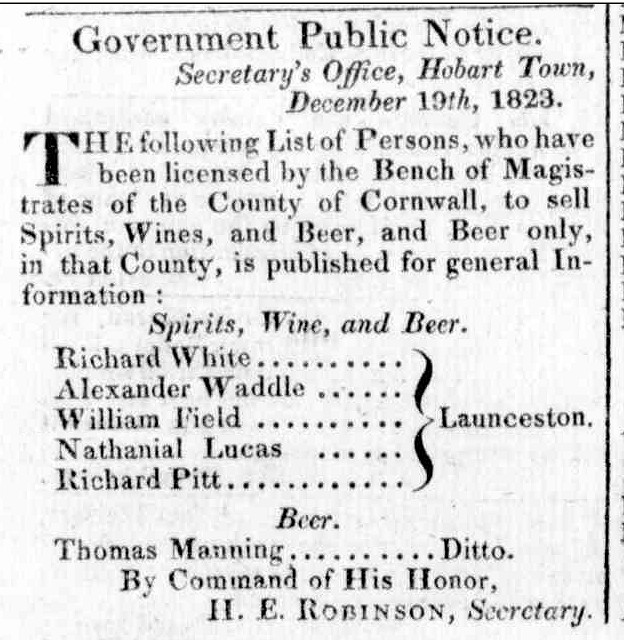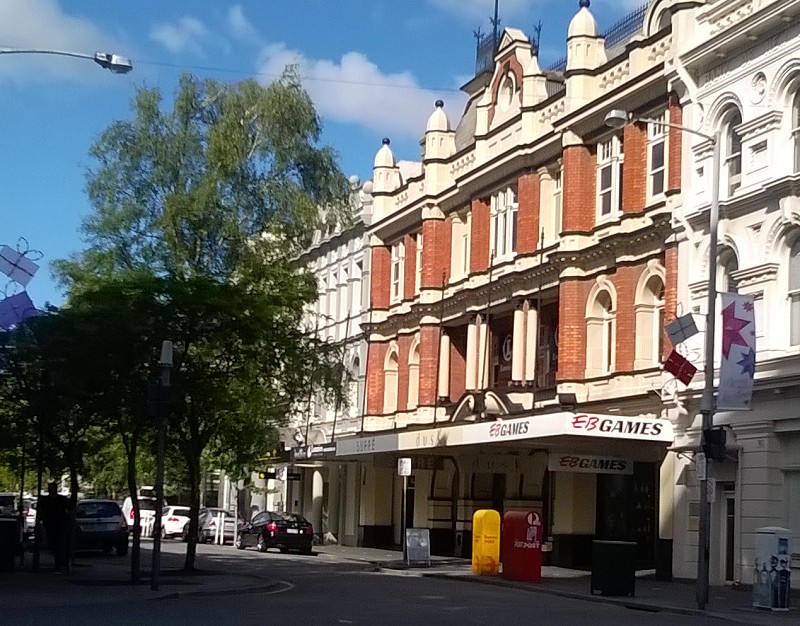I don’t know. So that was easy.
Longer answer:
According to Thomas Massey, Chief Constable of Launceston (and if anyone knows, you’d hope he would):
How long have there been Licensed Public Houses at Launceston?
About Four or Five years.
What has been the greatest number during the period?
Three. Now there are Two.
(Examination of Thomas Massey by J.T. Bigge’s, 29 April 1820, reproduced in Historical Records of Australia, Series III VIII p. 450.)
The earliest list of people licensed to sell spirits, wine and/or beer I’ve so far found appeared in the Hobart Town Gazette in December 1823. That’s three and a half years after Mr Massey’s statement.
(The signs for the above being: Launceston Hotel, Horse & Jockey, Plough Inn, Ship Inn, something at Ross? and Jolly Sailor.)
And the first mention of a hotel (or public house, tavern, inn or other related words) in Trove newspapers for the northern part of the island is also from 1823, an advertisement for a sale at “Mr. R. Whites’s Launceston Hotel”.
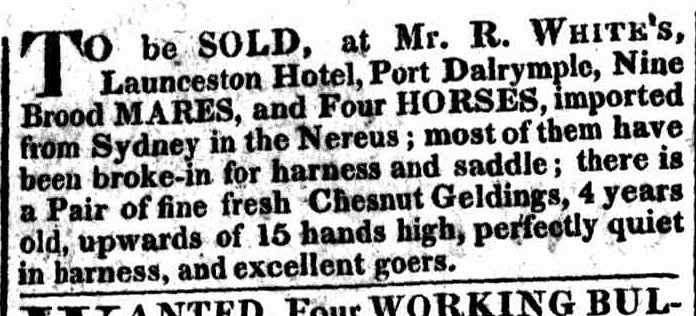
Hobart Town Gazette, 9 August 1823
So what were the 2-3 licensed premises the Chief Constable was referring to? Were they amongst the five above?
PETER LETTE
The day before Massey had his chance to talk, Richard Dry was examined:
What is Mr. Lette?
He keeps a public house in Launceston and is in the habit of receiving Grain in payment of spirits to the amount of many hundreds of Bushel’s in a year.
(Examination of Thomas Massey by J.T. Bigge’s, 28 April 1820, reproduced in Historical Records of Australia, Series III VIII p. 446.)
Unfortunately, the inquiry was more interested in the distribution of seed wheat than Peter Lette’s public house duties.
In “Day and Ways in Old Evandale” (available here), by Karl von Stieglitz writes:
Lieutenant Peter Lette, of the East India Company, arrived from Bengal with his wife Elizabeth and a family of 4 sons and 2 daughters, at George Town on the sailing ship “Hunter,” on May 20, 1817, where they stayed for a few weeks. A letter from Lette to the government records this fact. They came up the Tamar to Launceston and stayed at an hotel near the wharf. He received a grant in the Morven district which he called Curramore and built the house in 1826. He divided this property, calling the other half Mona Yale, 4 miles from Evandale, which was later put in charge of one of his sons. Between 1818 and ’20, Peter was the proprietor of an inn at Launceston which he later sold. In 1824 he owned Townsend cottage in Launceston and lived there.
This comes from a letter to Mr Von Stieglitz, from Amelia Wayn, “Chief Secretary’s Department, Hobart, 3.5.46” (QVMAG CHS 72 8/11 L24)
Arrived from Bengal, with wife & family, at Launceston on 20.3.17 — per S. Hunter – The family[?] landed at George Town &, apparently, remained there for a few weeks. A letter from P. Lette to the Government records the fact. He visited Lton shortly after and stayed at an Hotel near the wharf.
…
Between 1818 and 1820 Peter was proprietor of an Inn at Lton.
There is a collection of material related to Lette on the Familiy Search website (need to have an account, but free). Some notes suggest the inn was in Brisbane St/site of the Metropole Hotel.
There is also this entry from in account of the Police Fund (Hobart Town Gazette, 9 January 1819), which helpfully doesn’t say what type of licence.

So, I think it’s a good bet that Peter Lette has one of the licensed premises referred to by the chief constable. What about the others?
RICHARD WHITE–LAUNCESTON HOTEL
A lot of modern sources date the Launceston back to 1814. Like this one.. As best I can tell, that originates in a memorial White sent to Lt-Governor Arthur, requesting more land, that includes the line:
That your Honor’s Memorialist, arrived here in His Majesty’s Brig Kangaroo in the year 1814, from Norfolk Island, since which period he has kept a house of accommodation under the name of the Launceston Hotel.
That’s dated 23 December 1824. (I don’t seem to have a reference to the original source now, just a photocopy of a page that says it was “extracted by Geoffrey Minett” from the original document.)
From the newspaper extracts near the top of this post, the Launceston Hotel was obviously operating and licensed in 1823. Before that? I have not yet found anything conclusive, other than the wording of the memorial suggests an origin some time before 1824.
For someone who’s considered an interesting characters, there’s not much about Mr White online. There’s his trial at the Old Bailey, some arguing about whether he came from New York or England and some bits compiled here (you’ll have to use find) and a video by Jon the Curator. They all claim the establishment year the hotel as 1822, but without sources.
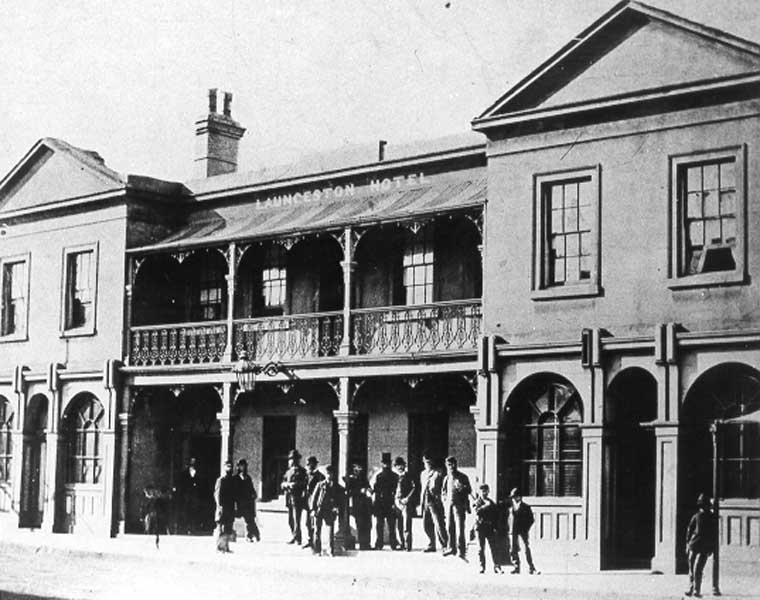
Launceston Hotel in earlier days (from State Library of Tasmania
What do 19th century writers have to say? From a lecture by Ernest Whitfield. 1897:
In 1820 came the first public house, “The Black Swan,” kept by G. Burgess, corner of Brisbane and Wellington streets. Then came in 1823 the Launceston, the Plough Inn, kept by W. Field, where Hart and Sons are now, and the Hope and Anchor, kept by Nat. Lucas. The Launceston Hotel, was built by Richard White, familiarly known as “Dicky White.” He was a Norfolk Islander, as also was his mate or comrade, Mr. Whittle (afterwards of the White Hills). In those days any free man could mark off a piece of land, settle on it, and procure a title afterwards. White pegged out the present site of the Launceston Hotel, and Whittle squatted alongside of him, and built a “wattle and daub” hut in the centre of what is now St. John-street.
Launceston Examiner, 6 February 1897
(As an indication of accuracy: as far as I know, Field’s Plough Inn was in Brisbane St (Hart & Sons were on Charles St), Lucas’s sign was the Ship, and the Black Swan doesn’t seem to appear until ~1826.)
The original Launceston Hotel was built about 1824 by Mr. Richard White, familiarly known as “Dicky White,” upon the site of the present main building. It was a one-storey wooden building, with a verandah in front, and was used as a hotel, while alongside it, at the corner now occupied by Mr. F. Hart’s three-storeyed establishment, was a one-storey wooden building where Mr. White carried on a second business as an auctioneer.
Examiner, 14 July 1885
In the year 1822 he received a license of occupancy for 1000 years for the land upon which the present Launceston Hotel stands, and surrounding premises. I know of only one other such license being given. The old Launceston Hotel was about the third or fourth house licensed in Launceston, the others being The White Swan, The Three Legged Man, and The Black Swan. At this time Launceston extended no further than Dicky White’s-street, now Brisbane-street, the extension of St. John-street, from Brisbane-street corner to York-street, was given jointly by Messrs. Whittle and White, and if the rope is put now across the street it will be found that that section of the street is narrower than any other. The Launceston Hotel early became a popular house, owing to the good management of the housekeeper.
Daily Telegraph, 27 February 1885
So, was White’s hotel one of those licensed in 1820? I haven’t yet found anything to indicate it was. I would be interested in anything that does confirm its existence before 1823 thought.
GEORGE BURGESS — BLACK SWAN

Cnr Brisbane & Wellington Streets, 1885, with the Wilmot Arms (former Black Swan) on the corner.
The Black Swan is a favourite candidate amongst older writers for title of first hotel. Examples being Whitfield, above, “In 1820 came the first public house, ‘The Black Swan,’ kept by G. Burgess, corner of Brisbane and Wellington streets”.
and this from “Colourful Old Hostelries” (1946):
The first hotel in Launceston was the Black Swan, built in 1820, and kept by G. Burgess, an old whaler. It stood on the corner of Brisbane and Wellington streets and was afterwards known as the Wilmot Arms before it was pulled down.
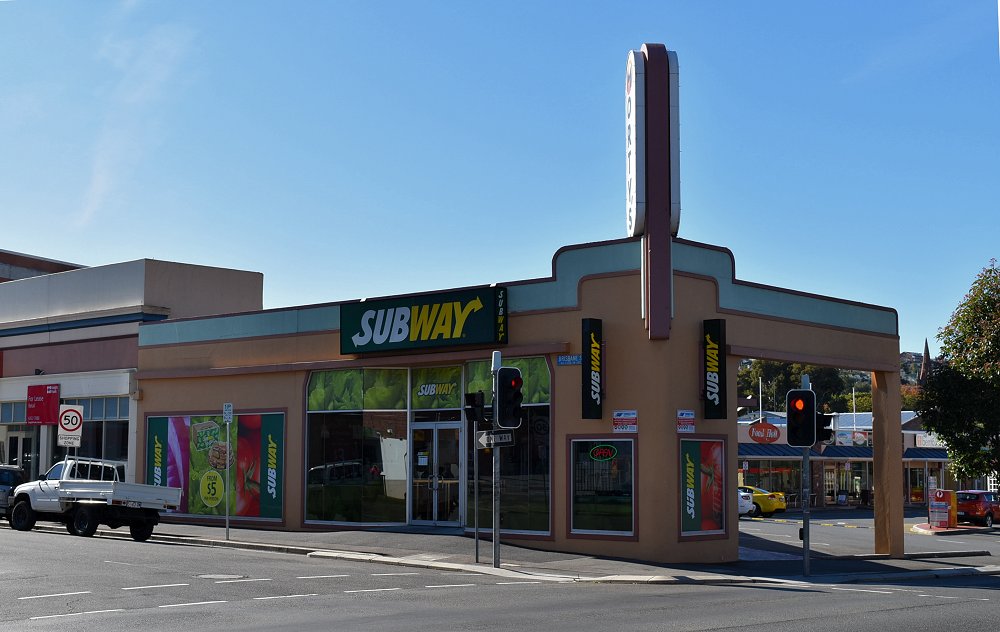
Cnr Brisbane & Wellington Streets. (2015)
But… the first mention of the Black Swan so far is from 1826. There it is in the middle:
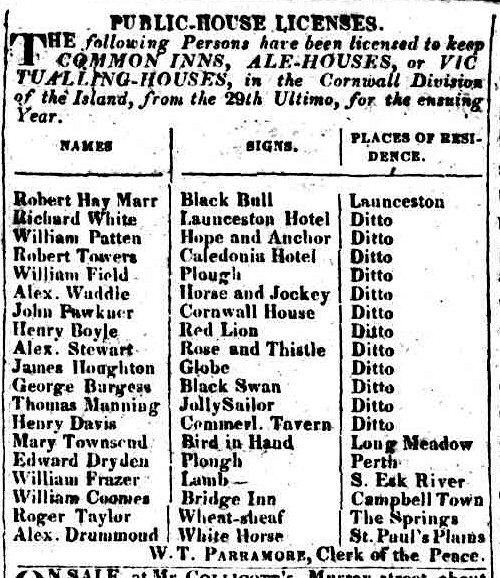
Hobart Town Gazette, 21 October 1826
Was it maybe operating as an unlicensed hotel before that? George and Elizabeth Burgess had a bunch of children, as people are prone to do. This is the christening record for one of their daughters, in 1826. Dad’s occupation is Labourer.

In 1827, when Alice is christened, he’s a Publican. Which matches with the licensing date.

Which doesn’t rule out a bit of unlicensed innkeeping on the side, I guess. But again, no evidence of a Black Swan or a Burgess as a license holder prior to 1826. It’s not to say that the writers might be mixing their names up. There might well have been a different Burgess who was an old whaler. A former whaler might well establish a hotel near the wharf.
ANY OTHERS…
Did you notice the “hotel near the wharf” mentioned in the lines about Lette?
Looking again at the extract from the Daily Telegraph article (1885), it says: The old Launceston Hotel was about the third or fourth house licensed in Launceston, the others being The White Swan, The Three Legged Man, and The Black Swan. I haven’t come across any White Swans or Black Swans or any other coloured Swans prior to 1826. Nor Three Legged Mans either.
SUMMARY
So, as candidates for Mr Massey’s 2 or 3 licensed houses we have Peter Lette’s house, a possible hotel near the wharf and… that’s about it. Short-lived licenses in temporary buildings no doubt, and the who and what and where has been lost to time.
I’d really appreciate any mention, no matter how small, of hotels in the Launceston prior to 1823.
